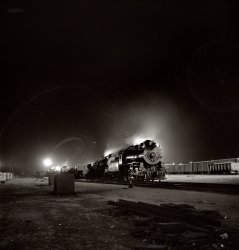
MAY CONTAIN NUTS

Search Shorpy
SHORPY ART

Framed or unframed, desk size to sofa size, printed by us in Arizona and Alabama since 2007. Explore now.
Join and Share
Ad-Free Shorpy
Shorpy is funded by you. Patreon contributors get an ad-free experience.
Learn more.

Recent comments
- Recent view
- Hudson’s Big Store
- Say what??
- Grapes?!
- A Beautiful Moment
- Such joy
- Bethune-Cookman University today...
- Yellow sky at morning
- Side Winder
- Air Quality?
- Sojourner Truth riot
- None were so blind(ed)
- The less famous sister
- Good ol' days?
- Rise and Fall
- Goo Goo Ga Joob
- Ticket Retention
- Not the only one
- Vagaries of War
- Killed by Amtrak
- Back to the Future
- Wanted --
- If you can't stand the light
- Centralized Traffic Control, I believe
- What's really happening
- Heckuva remote control!
- Sometimes — Things Go Bump!
- I SEE THE LIGHT
- Union Switch and Signal Company
- Get That Light Out Of My Eyes
Member Photos
The Shorpy
Print Emporium
Print Emporium
Search Shorpy
Search results -- 30 results per page
- Cloud Mountain: 1943
- ... Atchison, Topeka & Santa Fe between Vaughn and Belen, New Mexico, into the Rio Grande River Valley. In the distance is a quarry on ... Posted by Dave - 11/15/2013 - 8:14am -
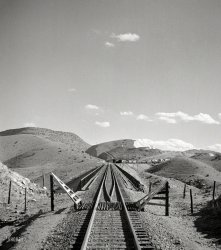
- Kids at Play: 1940
- May 1940. "Recess time at grade school in Hobbs, New Mexico." Medium format negative by Russell Lee for the Farm Security ... Posted by Dave - 06/18/2018 - 11:30am -
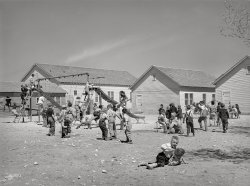
- Million Dollar Highway: 1940
- ... last frontier drives ever. We used to drive up from New Mexico to play basketball with Ouray and Silverton. This road made bus ... Posted by Dave - 04/23/2008 - 9:39am -
![Million Dollar Highway: 1940 October 1940. "Million Dollar Highway is cut through massive rocks in Ouray County, Colorado." U.S. 550 between Silverton and Ouray. Now a paved modern highway, this is a spectacular mountain route that I've driven many times over the years. View full size. 35mm Kodachrome transparency by Russell Lee.
Ouray ActivitiesThe creek you see at the bottom of the photo flows into Ouray and is diverted through perforated pipes set along the canyon rim in the winter. The sheets of ice formed by the water trickling over the rocks create a perfect ice climbing venue, with competitions every January and February. The creek flows into the Uncompaghre River (Native American name meaning "no cell service"). The hot springs in town are a great way to take the chill off your bones after a day on the ice.
[My favorite summer activity: Jeeping the Alpine Loop and exploring the ghost towns along the way. Especially Animas Forks. The Western Hotel in Ouray is a good place to stay. Or the Beaumont if you want fancy. - Dave]
Red Mountain Pass If I am not mistaken this section of road climbs over Red Mountain Pass.
A few years back I rode my bicycle over this pass, with 750 other riders,on the way to Durango. While it is now a "modern paved highway" it still has no guardrails as they would be an impairment to clearing the many feet of snow they get each year. The drop off right next to the edge of the road(first on the right side then the left) made some want to hug the center line, but the car traffic was not conducive to this.
The night before we left for the ride a shop owner in Ouray gave bikers this advice. "For the first 12 miles lean left. For the next 12 miles lean right."
Bus ride anyone?This is truly one of the greatest last frontier drives ever. We used to drive up from New Mexico to play basketball with Ouray and Silverton. This road made bus trips very interesting. Great photo.
HistoryThe Million Dollar Highway got its start in the 1880s as a 12-mile toll road between Ironton and Ouray, a remarkable feat considering it was before the age of the internal combustion engine and done by men with picks and shovels, working in snow and very low temperatures. Drive thru in the winter to appreciate. I've jeeped this area extensively... see pics at
www.fotki.com/tbill and
www.fotki.com/tbilmelms
550I remember riding over this highway during WW2 when I was a very small child. It wasn't paved yet and was just barely passable for two vehicles going in opposite directions. The driver always had to honk when approaching a blind curve, and the car on the outside had to move over and stop for the inside vehicle. I was terrified and spent much of the trip huddled down in the back seat with my eyes closed.
We lived in Pagosa Springs at the time, and I am a Colorado native, so mountain roads were nothing new to me. But this one was the worst. I was between 3 and 4 at the time.
Eek!I have driven this during the summer and even then I wanted to hug the centerline. I can't imagine driving this during the winter.
Golden RuleWhen I was a kid in the 40's, we were taught that the name for the Million Dollar Highway comes from the value of the ore-bearing fill that was used to construct it. As kids, we would gather mill tailings from the road sides in the mountains and take them home to extract gold by crushing and panning. We would alway get a few flakes of gold. I'm sure that there are few or none of these piles of tailings left because the price of gold now makes it profitable to use the very low grade ore.
(The Gallery, On the Road, Russell Lee)](https://www.shorpy.com/files/images/1a34174u.thumbnail.jpg)
- Grinder: 1943
- February 1943. "Moreno Valley, Colfax County, New Mexico. George Mutz's daughter grinding meat on the ranch." Our second look ... Posted by Dave - 04/23/2014 - 5:33pm -
![Grinder: 1943 February 1943. "Moreno Valley, Colfax County, New Mexico. George Mutz's daughter grinding meat on the ranch." Our second look at Mary Mutz in the kitchen. Photo by John Collier for the Office of War Information. View full size.
Wash your clothes - grind your meatI have an early 1930's Maytag washer with a gas engine on it. Also have the meat grinder attachment which allowed one to remove the wringer and attach the meat grinder. It still works as we have ground up venison with it. It's fun to take to antique farm machinery shows and show kids how it works by "grinding" play dough instead of meat. Keeps the flies down on those hot summer days.
I still have one of theseI use it occasionally to make bread crumbs!
Calling OSHAShe's pushing the meat in with her fingers? Not a chunky metal tool? My mother's grinder came with a tool and my mother taught me never to get my fingers near the opening well before I was 4.
[Maybe the recipe is Meat Loaf with Lady Fingers. - Dave]
Foley MillMy mother had one of these way back when.My job was to turn the crank so she could grind up the meat of the day, whatever it was. She did make killer sausage and hamburger with it!
I have one too. I have one down the cellar just like this also though I don't use it anymore. My mother used it to make clam cakes by grinding the clams in it.
Meat grinder memories.......one of which was my mother shoving chunks of otherwise inedible meat through a grinder similar to this. (With her fingers, of course.) But a much worse memory was the sound of it; all that muscle, gristle, fat, etc., being ground up into our next meal. Yuck.
[Not to mention the fingers. -tterrace]
She died with all her fingers, thank you! But she was terrified of those newfangled food processors. So dangerous!
We used this oftenfor potato pancakes. Mom & Dad would grind peeled potatoes, every once in a while throw an onion into the grinder and let the liquid drain off. Throw in a tiny amount of flour & seasoning. Fry in lard. Slather finished product with butter served with apple sauce on the side. This was the best dinner!
The finger-saving secretMy mom had one of these, and we used it for years. I wish I had it today, as it was much easier to use and clean than a food processor! As for the finger thing, my mother used more meat to push the meat through. When the meat was pretty much gone, she used a raw potato to push the rest of it through and clean the grinder. Other than receiving the proper cautions, I never thought it was dangerous.
My mom had one too!!!She would make ground bologna sandwiches! Oh the good old days. I wonder what happened to hers.
I see them around at flea markets & Ebay now & then.
(The Gallery, John Collier, Kitchens etc.)](https://www.shorpy.com/files/images/SHORPY_8d26254a1.thumbnail.jpg)
- Santa Fe Trailways: 1940
- ... June 1940. "Stage in front of the post office at Pie Town, New Mexico. This stage comes through daily except Sunday. It takes in cream for ... Posted by Dave - 06/15/2020 - 2:10pm -
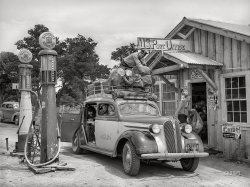
- Child of the Depression: 1935
- ... whose family resettled on the Bosque Farms project in New Mexico. Photograph by Dorothea Lange, 1935. View full size.
(The ... Posted by Ken - 09/08/2011 - 10:01pm -
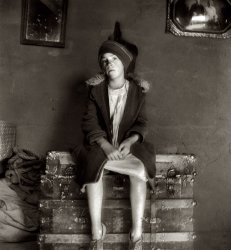
- J.D. Leon General Store: 1943
- ... of the J.D. Leon general store in Cerro. Taos County, New Mexico. 4x5 Kodachrome transparency by John Collier. View full size.
... Posted by Dave - 02/02/2008 - 1:26pm -
![J.D. Leon General Store: 1943 Spring 1943. Closeup of the J.D. Leon general store in Cerro. Taos County, New Mexico. 4x5 Kodachrome transparency by John Collier. View full size.
Wind GeneratorIs that a wind generator in the upper right of the photo? In many rural areas they were a common source of electricity for charging batteries.
[Most windmills like that were used for pumping water. - Dave]
Dogs?The one on the left looks like a sheep!
WindmillThere is no way that windmill was used to pump water...unless it charged batteries that ran an electric pump. It's a wind generator. That store owner was "green" before it was cool!
[Not quite. Windmills have been used all over the West for decades to fill watering troughs and storage tanks. They drive mechanical pumps. - Dave]
WinchargerMy vote is for a wind generator.
http://www.wincharger.com/ads/index.htm
Cow tanksMy father's family has a farm in Soutwest Nebraska and windmills were used to fill water tanks for cattle out in the pastures. The house had electric power for everything, but it was easier to set up a windmill out in the pasture were power lines were not available or dependable. Plus the willmills and water pumps were very easy for the farmer to fix, didn't have to call the power company and wait forever to a linesman to show up.
Outta GasSadly, I can't find any online records of remaining stations selling Conoco or any other gasoline in Cerro. Fuel up before heading out that way.
(Kodachromes, Dogs, Horses, John Collier, Stores & Markets)](https://www.shorpy.com/files/images/leon.thumbnail.jpg)
- Play Date: 1924
- ... border and then it looks to go through Lubbock into New Mexico. I tried looking at a few period maps but I can't figure out what ... Posted by Dave - 12/13/2014 - 9:50am -
![Play Date: 1924 February 21, 1924. Washington, D.C. "McLeod & Robt. M. Clancy." So what's going on here? National Photo Company Collection glass negative. View full size.
Blown TiresInteresting they are both left front tires. We have a manufacturing quality control issue here.
Repeal the TaxMichigan Congressmen Clarence J. McLeod and Robert H. Clancy consider repealing WWI era taxes.
Bad News/Good NewsSome kind of anti-tax publicity photo. Tag on the truck reads:
Bad News for the Owners
Good News for Uncle Sam
5% War Excise Tax Must Be Paid to Repair This Broken Wheel
The tax was imposed during World War I and hung on after the Armistice. As taxes tend to do.
Accident re-creationAt first I actually thought these guys might be recreating accidents, as we have seen previously here and here, but the scale is all wrong.
The Island of Broken ToysThis is where all the broken toys used to go and where our missing ones are still.
The race is onThey're making final preparations for the Congressional Pinewood Derby.
Strange RoadIn the map behind them there is a road or railroad that runs just south of the Texas - Oklahoma border and then it looks to go through Lubbock into New Mexico. I tried looking at a few period maps but I can't figure out what this line represents. Anyone have an idea?
[It's an outline showing drainage basin watersheds (and, not incidentally, the borders of the Louisiana Purchase). - Dave]
Or maybe they are considering a "flat" tax!
Precursor"If only we could get these to fit in a matchbox..."
(The Gallery, Cars, Trucks, Buses, D.C., Natl Photo)](https://www.shorpy.com/files/images/SHORPY-25353u.thumbnail.jpg)
- Shove It: 1942
- ... this time. The 200th Coastal Artillery Regiment was a New Mexico National Guard anti-aircraft coastal artillery regiment, converted ... Posted by Dave - 12/06/2013 - 7:54pm -
![Shove It: 1942 March 1942. Virginia Beach, Va. "Fort Story coast defense. A tough job for soldiers is shoving the breech block of the giant howitzer into place. The screw threads help the block to withstand millions of foot-pounds of pressure caused by the exploding charge." Photo by Alfred Palmer, Office of War Information. View full size.
Being a pedantic engineer.The term would be "pounds per square inch" of pressure. "Foot-pounds" is a unit of torque, not pressure.
[Foot-pound can also be a unit of energy. - Dave]
Doughboy helmetsRather than the pots that soldiers cooked in from WW2 until the advent of Kevlar in the late '80s, these guys appear to be wearing leftovers from the previous war.
Keep Strapped, Boys!Many a soldier's neck was broken from exploding ordnance within their proximity during WWI, thanks to the chin strap. No wonder many doughboys refused to strap themselves in.
Where?Is it just me, or does it have the look of being shoot in a studio or on a sound stage?
[It resembles that look because Palmer aimed supplementary flash from the right to illuminate their faces, which otherwise would have been in shadow. -tterrace]
All dressed up and nowhere to goExcept for the defense of Corregidor in 1942, a few engagements during the Civil War, and some salient actions during the War of 1812, the US Army's seacoast artillery never fired a shot in anger. Nevertheless, that arm was responsible for many innovations, particularly in fire direction techniques and gun design, that paid significant dividends when applied by the field artillery in both world wars, Korea, Vietnam, and the Gulf.
As for the WW I-style helmets, they were retained in low-priority units (such as Stateside coast artillery batteries) well after we entered WW II because priority for the new "steel pot" helmet naturally went to units deployed or deploying into harm's way. Army and Marine units that left the States after Pearl Harbor did so with the new helmet, of course, but those troops fighting in the Philippines from December 1941 to April 1942 had to be content with the Doughboy's "tin hat," designed primarily to protect against overhead artillery bursts and virtually useless against anything else.
Into the Breech!Here's what the view in the other direction looks like.
Some of these 16" guns (this is a Navy model) were used for industrial purposes for super-high pressure powdered metal sintering.
This particular one is still in use today!
Doughboy Helmets part deuxMy father was drafted into the Army (7th Cavalry, no less) in mid-1940 and they were issued uniforms straight from WWI vintage complete with "salad bowl" helmets. While in the cavalry they wore wide brim "soft" hats instead of helmets. When the unit was converted to armor in 1944 they became an amphibious tank battalion and then wore standard tankers helmets.
From a different angleThese soldiers are man-handling the breechblock of a 16-inch caliber howitzer, a massive weapon that fired a shell weighing over a ton.
Here's a view of a similar breechblock on a 16-inch gun in the defenses of San Francisco that illustrates the scale of these artillery pieces. (The highly burnished steel shows the care that soldiers lavished on these huge -- and expensive -- weapons.)
M1917A1 HelmetLectrogeek, the helmets worn in the photo are the Model 1917A1--the shell is the standard Model 1917 of World War I vintage, but with an improved liner and chin strap assembly. The modification was authorized in 1936 and the modified helmets began to be produced in 1940.
The M1 helmet ["steel pot"] was adopted in the summer of 1941, but due to a delay in tooling up to produce the new helmet, the M1917A1's continued to be made through the end of 1941 and were widely used throughout 1942 until the supply of M1 helmets caught up with the demand. The older helmet was declared obsolete later that year and the M1 helmet would go on to serve through the mid 1980s.
Coastal ArtilleryMany Coastal Artillery regiments were converted to anti-aircraft units around this time. The 200th Coastal Artillery Regiment was a New Mexico National Guard anti-aircraft coastal artillery regiment, converted from a cavalry regiment in 1940. They were sent to the Philippines, arriving in November of 1941. A great number of them died in Japanese captivity
Finally a picture from here…I live at the beach, just blocks from Fort Story. It is a very small base and my friends and i would hang out there and skateboard down these hilly road that they built on the sand dunes. That was in the early 80's, but it is still the same now. We would sneak through the woods and "smoke" back there and find old bomb shells just laying the sand. 4ft long at least. They have a bunch of underground bunkers with doors that appear to go into a sand hill… Very odd looking with rusted old locks on the doors. There was a strip club on the base that we could also sneak into and drink at 16. I was never in the service, nor were my friends, but we certainly had a great time on that base. No one was ever around…? We never met a single military person. Still i have only met a few, and lived in Va. Beach for 44 years. Good Times. Thanks Shorpy.
BreachThis type of breach lock is known as buttress thread.
(The Gallery, Alfred Palmer, WW2)](https://www.shorpy.com/files/images/SHORPY_8e11187u.thumbnail.jpg)
- Band of Brothers: 1940
- June 1940. Pie Town, New Mexico. "Farmer and his brother making music." Photo by Russell Lee for ... Posted by Dave - 07/24/2012 - 7:01pm -
![Band of Brothers: 1940 June 1940. Pie Town, New Mexico. "Farmer and his brother making music." Photo by Russell Lee for the Farm Security Administration. View full size.
Background PhotosIt would be nice to have a close up of those family photos in the background. Also of the ring on the younger brother's hand, which is unusual.
[Done! A quarter in the tip cup would be nice. - Dave]
GuitarWow, I have a guitar that looks almost exactly like that one. It's a 1940s Swedish-made Levin bought by my father, and I learned to play with it.
Levin GuitarStarting (I think) in the late 1950's, Levins were sold in USA under the name Goya.
Guitar PlayerHe must be pretty good playing up at the 7th fret like that. Also, look at the tanned arms of the fiddler player.
(The Gallery, Music, Pie Town, Rural America, Russell Lee)](https://www.shorpy.com/files/images/8b25245u.thumbnail.jpg)
- Clovis Man: 1943
- March 1943. "Clovis, New Mexico. D.L. Clark, engineer, ready to start his locomotive out of the ... Posted by Dave - 06/17/2009 - 8:36pm -
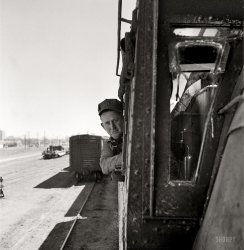
- Hawkeye Troop: 1956
- ... was 14 I went on an expedition to Philmont Scout Ranch in New Mexico. The troop I went with all wore the short-sleeved shirt (which had ... Posted by Dave - 09/08/2012 - 6:29pm -
![Hawkeye Troop: 1956 "Boy Scouts 1956." Our young friend Kermy is holding the flag on the right in this Kodachrome slide found on eBay. View full size.
Balmer BoysOverlea is part of Greater Baltimore. Today's Maryland Troop 433 is now located in Olney which is west of the city.
http://www.troop433.org/
Jungle GreensFor some reason the poses in this shot, particularly of the lads squatting at the front, remind me of photos of young soldiers in Vietnam or Korea.
I guess a few years into the future from here, these lads may well have been those soldiers.
Uniformed and proud.A time when the BS wore full uniforms and looked the part. I remember having to wear the official shorts, socks, shirts, berets etc. We were proud to do that as well and were always dong some volunteer task the town asked us for. We had a huge Scout troop in my hometown 40-60 at one time. I recently went back for the 4th of July parade in the hometown and was dismayed at the look the local Scouts took on. 7-10 members now shuffling down the street: shirts un-tucked, baggy cargo shorts, flip flops; barely any trace they were indeed BS. Total slobs. Oh well.
Kermy's from Maryland!I would have guessed Iowa, glad to hear it.
Mounting evidenceSomething tells me the evidence will start building sufficiently from these photos to track down Kermy and his sister.
I wore that uniformMinus the convenient folding brimless hat, whatever you call it. I know the hat is military in origin, but I also associate it with fast food clerks. When we wore hats at all, they were ball caps.
I was one of the last Scouts to wear this style uniform. The new uniforms, with the lighter-color shirts and epaulets, were introduced about 1981. I wanted to be up to date, but my parents had just bought my uniform and were determined to wait until I outgrew it, which I did soon enough.
The Scout troops that beat everybody else in the knot-tying competitions must have worn their uniforms all the time. That wasn't us. It was only much later that I understood that they were busy perfecting these skills, while we were backpacking 100 miles, and climbing Mount Whitney. I think we had more fun.
1950 censusI wish we had access to the 1950 census, so we could look for a family in Overlea, Maryland, with a little boy named Kermit (at least I can't think of any other name that Kermy would be short for).
azhdragon is right. These kids would have been in the age group of most who served in Vietnam. Its a very sobering thought.
Scout seniorityWhen I was in Boy Scouts in the early 80s, we had the recently-introduced khaki shirt with dark OD green trousers and a mesh back baseball cap [OD green with the BSA emblem in center]. However, some of the older Scouts and a few of the adult leaders still had the old style, all-OD green uniform as shown in this photo. Sort of an indication that they were "old-timers" and still wore the older uniform to prove it. It definitely looked a lot sharper than the ones we had and was also more comfortable.
This could have beena picture of my troop in the early 60's. The garrison cap worn by these Scouts was still the official "topper" for scouts of my era.
Not that Troop 433Troop 433 of the Balto. Council still meets at a Methodist church in Perryville.
I've been trying to identify the campsite but it's not obviously either of the two local boy scout camps (Broad Creek or Hawk Mountain) or in Patapsco Park on the other side of the city.
The poseI noticed their poses as well. I think they were very consciously (without realizing it, if that makes any sense) mimicking the poses they saw their fathers taking in the unit pics from WW II.
I was a Cub Scout in 56, but graduated to the green uniforms in 1958. That hat style was what we called a garrison cap in the Marine Corps, but it had a slightly ruder common name, the p*ss cutter.
BSAMost of these kids are probably about 2 years older than me. I was a Cub Scout in Kansas from 1956 to 59, and a Boy Scout from 1959 to 1964. We all wore the long-sleeved shirt, which for reasons I never understood required you to fold the collar inside the shirt before putting on the neckerchief. When I was 14 I went on an expedition to Philmont Scout Ranch in New Mexico. The troop I went with all wore the short-sleeved shirt (which had no collar), short pants, and a campaign hat (which was an optional item.) After that, I never went back to the long-sleeved shirt, even in winter.
(Boy Scouts, Kermy Kodachromes)](https://www.shorpy.com/files/images/SHORPY_Scan-120821-0003.thumbnail.jpg)
- Pie Town Singers: 1940
- ... of the ladies' quintet at a community sing in Pie Town, New Mexico. View full size. Medium-format safety negative by Russell Lee. ... Posted by Dave - 07/24/2012 - 7:03pm -
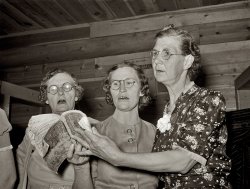
- Backtrack: 1943
- March 1943. "Willard, New Mexico. Santa Fe flagman walks back to signal any oncoming trains during a ... Posted by Dave - 08/31/2017 - 3:54pm -
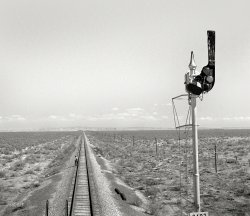
- Bosque Farms Baby: 1935
- ... December 1935. "Resettled at Bosque Farms project in New Mexico. Family of four from Taos Junction shows temporary dwelling." ... Posted by Dave - 12/27/2012 - 10:33am -
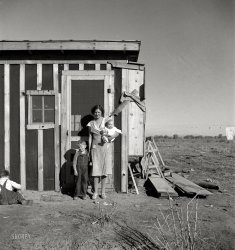
- On Second Thought: 1939
- September 1939. "Sign along the road near Capulin, New Mexico." Photo by Russell Lee for the Farm Security Administration. View ... Posted by Dave - 11/25/2017 - 4:45pm -
![On Second Thought: 1939 September 1939. "Sign along the road near Capulin, New Mexico." Photo by Russell Lee for the Farm Security Administration. View full size.
Hotel YuccaThe building is now a bank but the swastikas remain around the upper perimeter. More info at Hotel Yucca history.
"An interesting history"https://blogs.uh.edu/hotel-historian/2013/03/04/yucca-hotel-new-mexico/
"Freshening the Brand"... as we say in the marketing biz.
"Rest Assured"Rest assured of what? Since it's in quotation marks, I guess it's no guarantee of whatever they have in mind. Kind of like the farmer's market down the road from me with its "Fresh" Vegetables sign.
Native AmericanThe swastika had various innocuous meanings for Southwestern Indian tribes, hence the hotel theme.
Resting assuredI think the "rest assured" means "you are assured to get a good rest here. Safely and comfortably."
[Indeed. It's a pun -- a play on the common idiom "rest assured", the twist being that it's meant literally, in the sense of sleeping or relaxing, as opposed to the figurative sense of "be confident." - Dave]
What They Did Not See ComingThis wasn't an isolated case.
(The Gallery, Russell Lee, WW2)](https://www.shorpy.com/files/images/SHORPY-8b22737u.thumbnail.jpg)
- Unread Messages: 1943
- March 1943. "Isleta, New Mexico. The Santa Fe depot. Horizontal arms on pole indicate a 'red beard,' ... Posted by Dave - 08/07/2016 - 12:21pm -
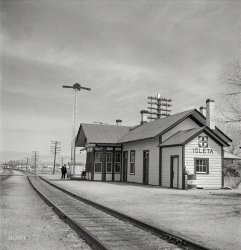
- Vanishing Point: 1943
- ... Atchison, Topeka & Santa Fe between Belen and Gallup, New Mexico." Photo by Jack Delano, Office of War Information. View full size. ... Posted by Dave - 12/15/2013 - 12:32pm -
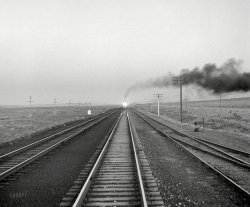
- Parched Okies: 1939
- ... days and nights it is from Ardmore, Oklahoma to Roswell, New Mexico at only one horsepower, but reckoned I'm with grandma, no matter the ... Posted by Dave - 02/15/2013 - 11:34am -
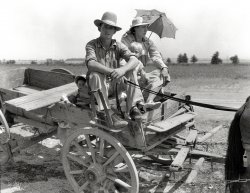
- Llano de San Juan: 1940
- July or October 1940. Church at Llano de San Juan, New Mexico. View full size. 4x5 Kodachrome transparency by Russell Lee, ... Posted by Dave - 08/30/2012 - 2:01pm -
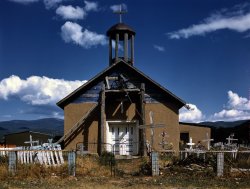
- The Sheltering Sky: 1943
- ... Topeka & Santa Fe Railroad in the vicinity of Encino, New Mexico. View full size. 4x5 Kodachrome transparency by Jack Delano for ... Posted by Dave - 08/30/2012 - 3:28pm -
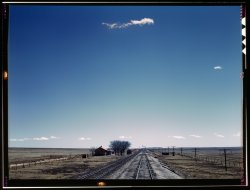
- Family Trip: 1937
- ... across the desert in search of work in cotton at Roswell, New Mexico. U.S. Route 70, Arizona." Where are the cupholders on this rig? ... Posted by Dave - 06/29/2013 - 11:22am -
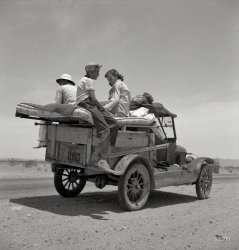
- Questa: 1939
- September 1939. "Street scene. Questa, New Mexico." One last look at the business district of this bucolic burg before ... Posted by Dave - 06/19/2018 - 11:25am -
![Questa: 1939 September 1939. "Street scene. Questa, New Mexico." One last look at the business district of this bucolic burg before we motor west. Medium format acetate negative by Russell Lee for the Farm Security Administration. View full size.
Indian(a) Gasoline, father of TexacoIndian Refining Company was one of the ancestors of Texaco. I found this page with a history of Indian Asphalt/Indian Refining of Indiana (only sort of), Havermeyer Oil (the creators of Havoline motor oil), and Texaco in all its variations.
Given how Indian and Texaco's histories are intertwined, I'm not the least surprised to find an Indian pump installed at a station sporting a Texaco sign.
Indian GasThe nearer pump globe sports an "Indian Gas" logo. Who has the dope on Indian brand gasoline? Bet those globes fetch a few bucks today.
Am I seeing right?Does the sign by the hood of the car really read "MONEY FOR SALE"?
[No, honey. - Dave]
Tivoli BreweryFounded in 1859, closed in 1969, and reopened in 2016 in its original Denver location.
If These Shabby, Flimsy Walls Could Only TalkThey might say a few things about a rough little town. Excerpt from Another Time in This Place: Historia, Cultura y Vida en Questa (2003) by Tessie Rael y Ortega and Judith Cuddihy:
"“At this time [1943], Questa had the most despicable reputation with anyone else. So Father Smith decided to do something. One day he got an axe and starting tearing down the bridge, the only way out of town. When people saw what he was doing, they were furious. They said, “What are you doing that for?” And Father Smith said, “If I don’t tear down the bridge, it’ll fall down.” The people said, “In that case, we’ll help you.” So they tore it down and then they realized what they had done. “Now we can’t get out of town,” they said. Father Smith said, “I guess you’ll have to build another one.” And they did.
Father Smith lived in a house on top of a hill where the Parish Hall is now located. From there he could see everything that was going on in town—who was fighting, who was hanging out in bars, and so forth. One day he had a police siren mounted on top of his car. Whenever he saw a disturbance, he’d turn on the siren and go down. He said to them, “Did you see it? Did you hear it? Then swallow it.” He succeeded in remodeling Questa. Two years later it won a prize for civil cooperation.”
Lunch SuppliesThe typeface on the Groceries sign looks very modern and a bit out of place compared to the others. Is it neon?
Sipping Four Roses at the Four Roses.That step just outside the door of the Four Roses Cafe seems like it would be trouble for a sober man but a man full of Four Roses Bourbon served by the saucy redheaded Four Roses barmaid would defy gravity and blessed drunkenness if he were able to navigate it and steer a homeward bound course.
(The Gallery, Gas Stations, Russell Lee, Stores & Markets)](https://www.shorpy.com/files/images/SHORPY-8b22880a.thumbnail.jpg)
- Meet the Mutzes: 1943
- February 1943. "Moreno Valley, Colfax County, New Mexico. Dinnertime on George Mutz's ranch." Our fourth visit with various ... Posted by Dave - 06/30/2014 - 7:09pm -
![Meet the Mutzes: 1943 February 1943. "Moreno Valley, Colfax County, New Mexico. Dinnertime on George Mutz's ranch." Our fourth visit with various members of the Mutz family. Photo by John Collier for the Office of War Information. View full size.
Mmmm - Cake for desert!Please pass the ketchup.
Remembering gingerbreadIn the olden days, Moms often whipped up freshly baked warm, home-made gingerbread for dessert. Sometimes it was topped with real whipped cream and chopped nuts. I reckon that is what the Mutz family is having tonight.
Clockwise from leftGeorge Herman Mutz Jr.; Robert George Mutz; Grandma (Tena Augusta Kaiser Mutz); Tina Jeanine Mutz; Helen Rose Mutz; Virginia Fern Mutz (hidden, and often misnamed "Mary" by Collier); George Mutz Sr.
[Regarding Mary, people are often known by something other than their given names. - Dave]
Re-Remembering GingerbreadI am from the UK originally and I remember my Grandma fixing this. Yum!!!
PitcherThe pitcher on the table is depression glass: "Manhattan" by Anchor Hocking.
Great photo.I could mistake this one for a Norman Rockwell painting.
(The Gallery, John Collier, Kitchens etc.)](https://www.shorpy.com/files/images/SHORPY-8d26144a.thumbnail.jpg)
- Free Air, Cash Meat: 1939
- September 1939. "Market and grocery in Questa, New Mexico." Medium format negative by Russell Lee for the Farm Security ... Posted by Dave - 06/15/2018 - 9:01pm -
![Free Air, Cash Meat: 1939 September 1939. "Market and grocery in Questa, New Mexico." Medium format negative by Russell Lee for the Farm Security Administration. View full size.
SignageI shutter to think what a picker wold pay for all those signs.
[It's "shudder." - Dave]
Equal relief for men & ladiesIf the meat or vegetables are not all that fresh and end up causing digestive problems, thankfully there are two outhouses to run to at the back of the grocery shop.
Fully equippedFully equipped with all the modern conveniences... including facilities for Men and Ladies out back.
I wonder why they were called 'Cash Markets'?In the town where I grew up there was a small store a couple of blocks from us, called "Scotties' Cash Market". It was was pretty small, but it had a lot of stuff packed in that space. Did a good business in the 1960s, but died a slow death in the 1970s when two things happened: (a) the town turned the street it was on (the Main Street) from two lanes with parking into four lanes and banned parking, and (b) a 7-11 clone opened down the street with off-street parking.
[It means you can't buy on credit or run up a tab. - Dave]
AvalonYou’d never guess they cost you less.
Everything a road traveler could need or wantOne very well stocked roadside market, cigarettes, tobacco, rolling papers, bags of flour, Coca Cola, free air and comfortable rest rooms.
Those OuthousesI hope the meat coolers were on the other side of the store.
Shorpy Parade of Pickups PastAbout a 1935 Dodle. If you go much earlier in the 30s, the Dodles I can find pictures of had rear-hinged "suicide" doors, at least on the driver's side. Of course, it's possible that Fiat Mercedes-Benz Chrysler Dodge Brothers built a pickup with a suicide driver's door and a regular passenger door, to clear the spare tire -- that would be a very Chrysler thing to do.
(The Gallery, Russell Lee, Small Towns, Stores & Markets)](https://www.shorpy.com/files/images/SHORPY-8b22879a.thumbnail.jpg)
- Iron Butterfly: 1943
- March 1943. Albuquerque, New Mexico. "Lifting an engine to be carried to another part of the Atchison, ... Posted by Dave - 10/18/2013 - 12:09pm -
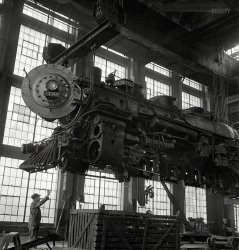
- Cow Town: 1943
- ... and Santa Fe Railroad between Amarillo, Texas, and Clovis, New Mexico." Nitrate negative by Jack Delano for the Office of War Information. ... Posted by Dave - 09/05/2012 - 6:07pm -
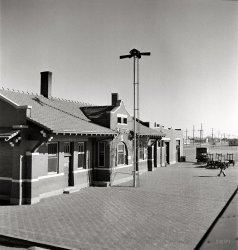
- My Ears Are Burning: 1940
- ... corn which he has roasted on top of hot stove. Chamisal, New Mexico." Photo by Russell Lee, Farm Security Administration. View full ... Posted by Dave - 11/25/2020 - 4:33pm -
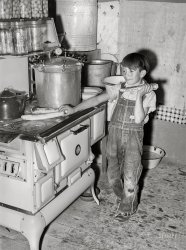
- Barroom Besties: 1940
- June 1940. "Youngsters in a bar at Mogollon, New Mexico." Medium format negative by Russell Lee for the Farm Security ... Posted by Dave - 09/24/2018 - 7:58pm -
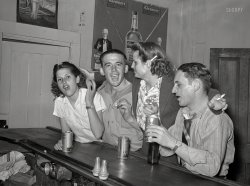
- Night Train: 1943
- ... on the steep and curvy Raton Pass grade in Colorado and New Mexico.
This begot one of the most popular wheel arrangements in America ... Posted by Dave - 01/07/2013 - 3:46pm -
